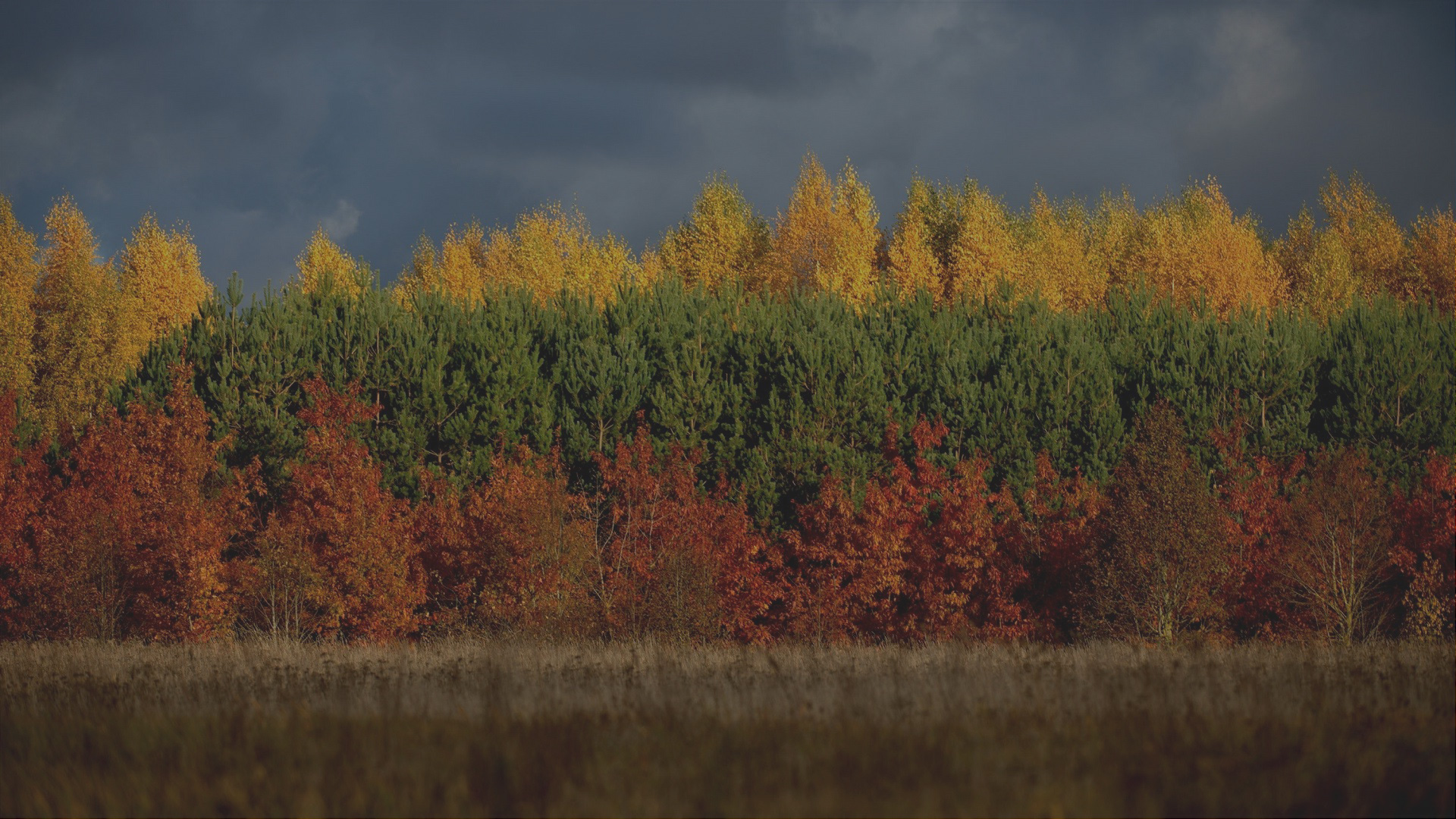OFFICIAL NAME: Republic of Lithuania
AREA: 65,300 km2
POPULATION: 2,810,865
OFFICIAL LANGUAGE: Lithuanian
CAPITAL: Vilnius
POPULATION OF THE CAPITAL: 542,664
Lithuania is at a crossroad between west and east Europe, and throughout its complicated history has developed a unique culture.
One of the three Baltic states, it is situated along the southeastern shore of the Baltic Sea. It is bordered by Latvia to the north, Belarus to the east and south, Poland to the south, and Kaliningrad (a Russian exclave) to the southwest.
Lithuania has an estimated population of 2.8 million people as of 2017, and its capital and largest city is Vilnius. The official language, Lithuanian, along with Latvian, is one of only two living languages in the Baltic branch of the Indo-European language family.
Lithuania covers 62,680 square kilometers of land and 2,620 square kilometers of water, making it the 124th largest nation in the world with a total area of 65,300 square kilometers.
Lithuania is a laky country: our country has more than 3000 lakes. Lithuanians are very fond of water. In lakes, they go swimming, fishing, water biking, boating, or canoeing. In winter, they go skiing or skating on the frozen ice.
Lake Drūkšiai is the largest lake of the country, covering about 44.5 square km. Lake Sartai’s 79 km shoreline is the longest one in Lithuania and lake Tauragnas is the deepest lake in Lithuania at 60.5 meters deep.
Rivers of Lithuania are typical lowland rivers: they are slow, they make meanders, the valleys are wide. Lithuania has 758 rivers that each are longer than 10 kilometers. Only 600 kilometers of the country’s rivers are navigable, however. The Nemunas is the longest river, entering the country from Belarus and flowing for roughly 475 kilometers within Lithuania before entering the Baltic Sea. The total length of the Nemunas River is 936 kilometers. Other significant rivers include the Neris, 510 kilometers; the Venta – 346 kilometers; and the Šešupė – 298 kilometers.
There are no major mountain ranges or volcanoes in Lithuania.
CONTACT
Mr Nerijus Kupstaitis
Director of the Department of Forests
Ministry of Environment of the Republic of Lithuania

LITHUANIAN FORESTRY AND FORESTS
Lithuanian forests – a natural element of the Lithuanian landscape offering biodiversity, productivity and sustainability, providing timber, green energy, food products and opportunities for healthy recreation of the urban and rural people. According to data from the Lithuanian Statistical Yearbook of Forestry (2016), the total forest land area is 2,186,000 ha and covers 33.5 % of the country’s territory. Since the 1st January 2003, the forest land area has increased by 141,500 ha corresponding to 2.2% of the total forest cover. During the same period, forest stands expanded by 107,300 ha to 2,058,300 ha (see Fig. 1).
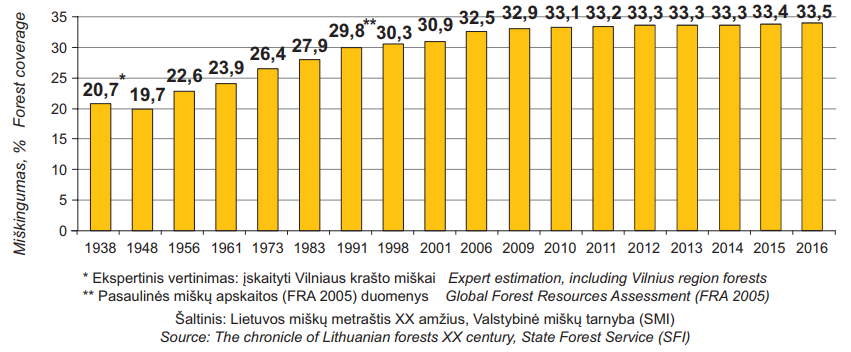
Figure 1. Forest coverage in Lithuania, 1938-2016
Forest classification
At the beginning of 2016, the distribution of forests by functional groups was as follows. Group I (strict nature reserves): 26,500 ha (1.2%); group II (ecosystem protection and recreational): 266,500 ha (12.2%); group III (protective): 333,400 ha (15.2%); and group IV (commercial): 1,560,300 ha (71.4%). Group IV commercial forests are split into a) commercial forests of normal cutting age, forming form productive forest stands and supplying wood continuously, following the requirements of environmental protection; and b) forest plantations, where the objective is to grow as much wood as possible in the shortest period of time. These are forests which consist of stands of fast-growing tree species with a cutting age of at least 15 years. Only stands with the same age class can be attributed to forest plantations. It is prohibited to plant forest plantations in non-plantation forest cutting areas.
Forestry structure
Occupying 1,148,400 ha, coniferous stands prevail in Lithuania, covering 55.8% of the forest area and 44% are deciduous species. The most common tree species are Scots pine, Silver and Downy birch, Norway spruce, Black alder, Grey alder, Aspen and Oak (Fig.2).
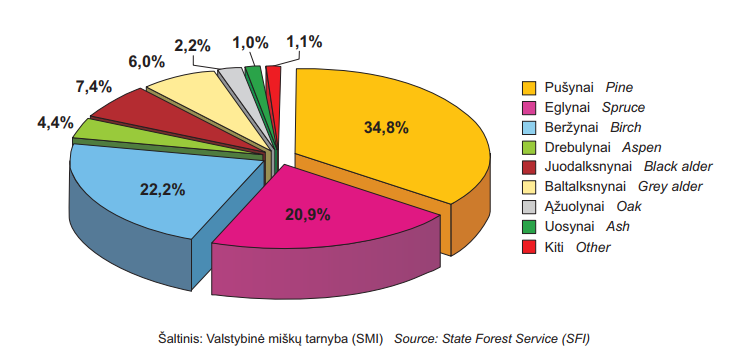
Figure 2. Forest stands area by dominant tree species
They are followed by softwood deciduous forests (835,900 ha, 40.6%). Hardwood deciduous forests occupy 74,000 ha (3.6%). The total area of softwood deciduous forest land increased by 137,400 ha over the last thirteen years. The area of hardwood deciduous has decreased by 18,600 ha (mainly due to dieback of ash stands) and coniferous forest by 11,500 ha. Scots pine occupies the biggest share in Lithuanian forests – 716,000 ha. Compared to 2003, the area of pine expanded by 4,500 ha. Norway spruce stands covers 430,000 ha, with a reduction of 15,300 ha. Birch stands covers the largest area among deciduous trees. Since 2003, it increased by 65,500 ha and reached 457,700 ha by the 1st January 2016. Area of black alder increased by 33,600 ha, to 153,100 ha. The area of grey alder expanded by 600 ha i.e. essentially less than the black alder stands, reaching 122,600 ha. The area of aspen stands expanded by 32,400 to 89,700 ha. The area of oak stands increased from 35,700 ha to 44,900 ha. The area of ash stands diminished by half to 21,500 ha. The average forest area per capita increased to 0.76 ha. NFI data presents data since 2003, when inventory by the sampling method was implemented across the whole country.
Forest stock volume, increment and logging
The total growing stock volume is 537 million m3, while the gross annual increment is 19.3 million m3 (see Fig. 3)
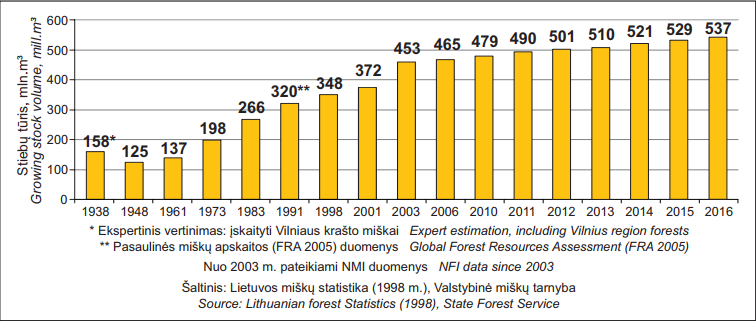
Figure 3. Growing stock volume, 1938-2016
Standwise forest inventory underestimated the volume of stands by 10-15%, therefore the transition to the NFI was made. For this reason, a sudden increase in timber volumes and area of matured stands was observed since 2003. According to NFI data, since 2003 total growing stock volume increased from 453.4 million m³ up to 537.0 million m³. Pine stands accumulated growing stock of 221.0 million m³. In a period of thirteen years they accumulated 41.0 million m³.
The growing stock in spruce stand increased from 75.8 to 91.2 million m³. The volume of birch stands increased by 9.9 million m³ to 88.7 million m³. The stocks of black alder have risen by 14.6 million m³, reaching 52.3 million m³. 37.6 million m³ were accumulated in aspen stands and this volume practically is the same as twelve years ago. The volume of grey alder stands remained at the same level (22.3 million m³). Oak stands accumulated growing stock of 11.8 million m³. Ash stocks decreased more than twice and were 3.2 million m³. The average growing stock volume in all forests since 2003 increased by 28 m³/ha up to 254 m³/ha. The growing stock volume of mature stands in III-IV forest groups has increased from 109.9 to 147.3 million m³ in average 3 million m³ per year. The gross annual increment increased from 16.0 to 19.3 million m³ in average 9.2 m³/ha per year. The average growing stock volume per capita reached 186 m³.
Felling operation
The amount of prepared merchantable round wood decreased by 10% and amounted 6.7 million m³ in 2015.
Changes in felling rates in state forests were insignificant over last four years. The amount of round wood harvested in state forests totaled 3.8 million m³ in 2015. From this, 3.6 million were felled by enterprises themselves or by contractors, while stumpage sales made up 0.2 million m³ (see Fig. 4).
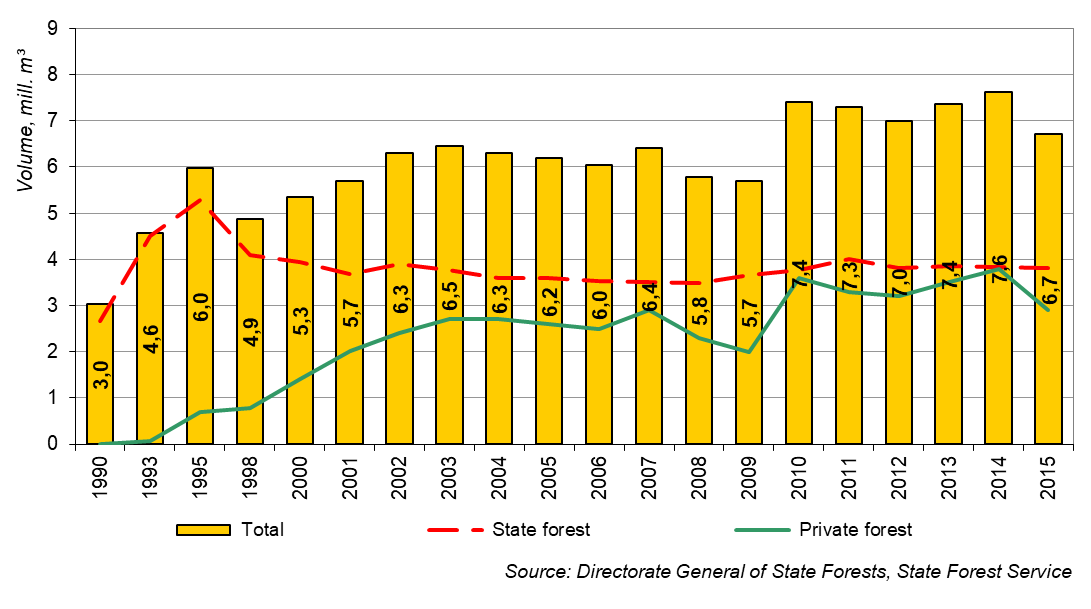
Figure 4. Fellings by forest ownership categories, 1990-2015
The volume from the final felling in state forests increased by 2% to 2.7 million m³. The share of the final felling constituted 72% in the total harvest (70% in 2014). For coniferous, the extent of final felling increased by 2% until 1,292,000 m³. The roundwood volume from final felling increased by 5% in spruce stands and decreased by 2% in pine stands. Volume of prepared wood in these stands amounted to 665,000 m³ and 627,000 m³ respectively. For non-coniferous, the round wood volume from final felling increased by 2%, to 1,447,000. Felling in birch stands grew up by 2% from 720,000 m³ to 738,000 m³. For aspen, the increase was 3% and removals totaled 334,000 m³. The prepared wood volume in black alder stands increased by 5% to 291,000 m³. For other species, the removed volumes and changes were as follows: 49,000 m³ grey alder (3%); 16,500 m³ ash (-14%); and 12,500 m³ oak (-4%).
The volume from intermediate felling in state forests decreased by 6% to 1.1 million m³. The heavy storms bypassed Lithuanian forests and amount of selective sanitary felling decreased by 14%, from 430,000 m³ in 2014 to 368,000 m³ in 2015. Other felling (mainly clear salvage felling in immature stands) decreased from 97,000 m³ to 90,000 m³.
The volume of wood prepared by commercial thinning decreased by 1% until 595,000 m³ and constituted to 16% in the total harvests.
The felling rate in private forests decreased to 2.9 million m³ (expert evaluation). Private forest owners received cutting permits for 2.3 million m³. Half of this (1.1 million m³) was issued to cut in coniferous stands. The allowable cut of pine stands decreases from 706,000 m³ in 2014 to 545,000 m³ in 2015. The allowable cut in spruce stands increased by 20% to 576,000 m³. The amount of possibly felled wood in birch stands increased by 20% and reached 669,000 m³.
State forest enterprises spend more money to pay for services of private logging companies. These companies performed wood harvesting and haulage works which worth was EUR 37.3 million compared with 32.2 million in 2014. Contractors harvested 77% (78% in 2014) of timber produced in State forest enterprises. Twelve state forest enterprises from 42 contracted out 100% of harvesting works. Contractors hauled 58% of the prepared timber (58% in 2014) (see Fig. 5).
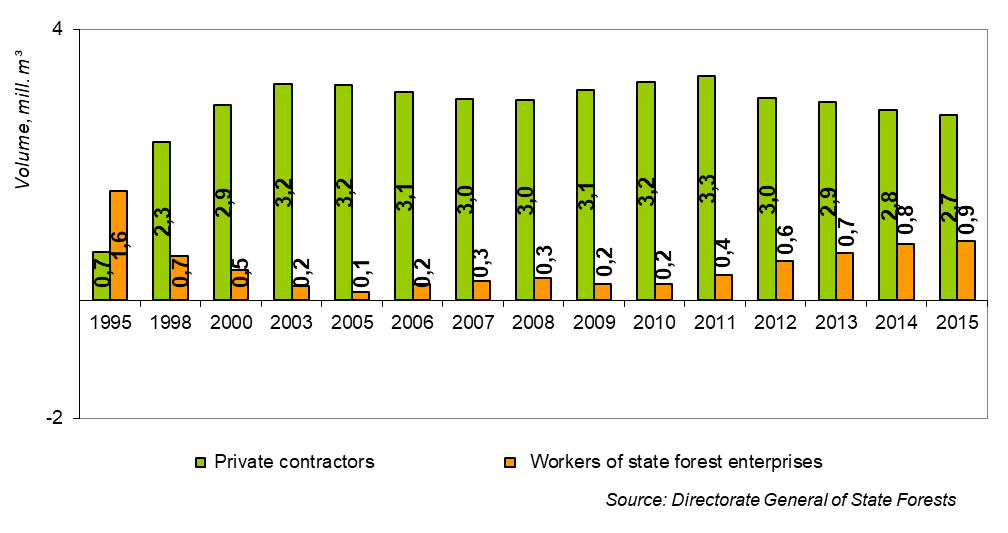
Figure 5. Fellings carried out by private contractors in state forests, 1995-2015
The planned felling volume in the next 10 years
According to data from the „Lithuanian Forest Resources in XXI Century“ (Kuliešis A., Petrauskas E., 2000) in 2001-2030 mean gross annual increment in state importance forests rises. In state forest for all three decades is sustained a slightly increasing final and intermediate use, very stable volume of salvage cuttings.
Growing stock use forecast is presented observing mean gross annual increment balance and its regulation principles. Forest growing results may vary depending on forest regeneration method, forest growing, stand formation regime. All this depends on economic conditions, timber industry and forestry development in Lithuania (including timber processing) and on their place in the economy of the country.
ECONOMIC ASPECTS OF FORESTS
Forest Management
Forest policy formation in Lithuania is under the responsibility of the Ministry of Environment (MoE). The MoE maintains position of the vice-minister dedicated for the nature protection and forestry issues. The Nature Protection and Forest Department is located within the ministry and it is directly involved in formation, organization and coordination of forest policy and strategy.
State Forest Service implements state forest policy in forests of all types of forest ownership. There are 8 territorial units located in the regions of Lithuania directly involved in the quality control of forestry activities, consulting of forest owners, etc. State Forest Service also performs the state control of forest condition, use, reforestation, afforestation and protection, executes National forest inventory by sampling method, forest health monitoring (on ICP-Forest grid), manages State Forest Cadaster and forest databases, assess forest resources and conducts international reporting, prepares scheme of forests of state importance, guides forest sanitary protection, maintains forests genetic resources, controls quality of forests seeds and seedling material, monitors deforestation process, arbitrates forest presence under Forest Law norms, methodically guides Standwise forest inventory, controls its execution, issues cutting permits to forest owners, administrators and users, etc.
42 State Forest Enterprises (SFEs) are trusted with the management of state forests. The General Directorate of State Forests is mediating organization, responsible for supervision and coordination of activities carried out by the SFEs. The consolidation process of 42 SFEs into one legal entity – State Enterprise for management of state forests – started in 2017 and it’s aimed at optimization of the governance and creation of the economically effective management body for the long perspective.
There are some other institutions directly or indirectly involved in protection of environment (incl. forests), forest management planning, land (forest) reform, administration of EU funding for forestry measures. It is Regional Environment Protection Departments, State Service of Protected Areas, Forest Management and Planning Institute, also Forest Science and Education Institutions, National Paying Agency, Non-governmental institutions, etc.
The Forest Owners Association of Lithuania (FOAL) is the public organisation in Lithuania representing and uniting private forest owners. FOAL was established in 1993 and now has 37 local branches with more than 1600 active members. It is forecasted that, after the completion of Land Reform, private forests will occupy nearly 45 % of all forestland in Lithuania. By 1st January 2016 the number of private forest owners amounted to almost 249,100, a forest estate averaging 3.4 ha. The main services that FOAL is providing for its members are:
- Information and consultancies about private forestry;
- Education of private forest owners on silviculture and forest management related issues;
- Representation of private forest owners.
Being a public organisation, the association is actively promoting the cooperation among private forest owners’.
Forestry employment
According to official statistics, the number of employees in State Forest Enterprises was rather stable in last 5 years (about 4 thousand). Since 2001 to 2009 total number of employees declined by more than 40 %.
The main reason of decreasing numbers of employees are forest fellings by subcontractors and privatization of sawmills. great influence to the decrease was made by the start of forest privatization. Forest area managed by forest enterprises has decreased and the number of forest districts in enterprises has declined. However, the total number of employees in Lithuanian forestry sector has not decreased as much as the number of employees in private forestry sector increased in the last years.
Forest ownership
By 1st January 2016, around a half of all forest lands in Lithuania was of State importance – 1088,500 ha. 873,000 ha of private forests were registered in the State Enterprise Centre of Registers.
Forty two State Forest Enterprises under subordination of the Ministry of Environment, managed 1,050,200 ha of forest land. The number of forest districts (structural unit of SFEs) during the last year decreased by 9 until 341 with an average size of 3,200 ha.

Figure 10. Forest land by ownership
Private owners managed more than half of the forest area in Anykščiai, Utena, Varėna, Veisiejai state forest enterprise territories. Private forests in teritories of Druskininkai, Kupiškis, Rietavas, Rokiškis, Telšiai and Zarasai state forest enterprises covered from 45% to 50% of forest land. The smallest area of private forests was in Dubrava, Kazlų Rūda, Joniškis and Marijampolė state forest enterprises territories. The area of private forests did not exceed 7,000 ha, or 22%, in either of these enterprise territories.
By 1st January 2016 the number of private forest owners amounted to almost 249,100, a forest estate averaging 3.4 ha (see Fig 11).
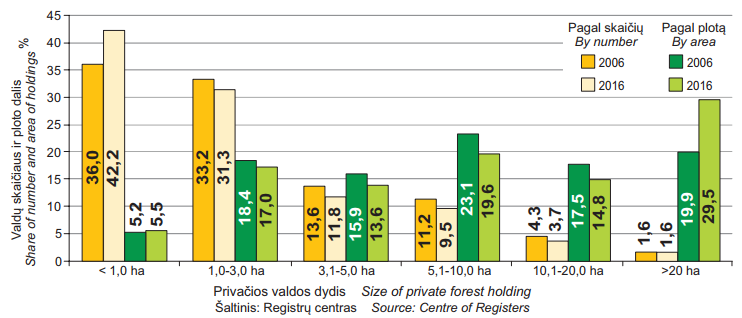
Figure 11. Number and area of private forest holdings by size of holding
Forestry policy
The Forest Law was adopted on 22 November 1994 and later updated several times, including completely new edition in 2001. In addition to the law, a “Forestry and Forest Industry Development Programme” was approved by the Government in 1994 and updated in 1996. It contains many issues related to forestry policy and contains linkages with the Programme of Diversification of activities in areas less suitable for farming, the Rural Development Strategy and the National Sustainable Development Strategy. The Programme promotes the use of wood based energy, in accordance with the National Energy Strategy. Afforestation of abandoned agricultural lands, which is a part of the rural development strategy, is reflected in the Development Programme as well. The Action Plan annexed to the Programme foresees the actions to be undertaken in forestry sector up to the year 2023. Since 1997, international forest certification schemes have been taken into consideration in Lithuania, promoted by state forestry authorities. Lithuanian Biodiversity Conservation Strategy and corresponding Action Plan were prepared by the Ministry of Environmental Protection and approved by Parliament in 1998.
The Lithuanian Forest Policy and its Implementation Strategy was approved in 2002. This crucial document covers the forest policy formulation principles, guidelines of the forest policy, SWOT analysis and the vision of the forest sector, the mission of the state and strategic forest development objectives. IPP/IFF proposals for actions and the spirit of other international commitments were the main driving forces preparing Lithuanian Forest Policy, its Implementation Strategy and the corresponding Action Plan.
In 2012, Lithuania adopted the National Forestry Sector Development Programme for 2012–2020. It is an important Government level document of strategic planning for forest management, covering forestry development strategic objectives and concrete actions for achieving these objectives until 2020, as well as responsible authorities and sources of funding the Programme. The strategic objective of forestry development is to increase multiple benefits provided by forests to society, taking into account the long duration of forest growth, different forms of ownership and their interaction, and also by ensuring the implementation of sustainable forest management in all forests of the country.
Lithuanian forestry policy is based on the principles of sustainable forest management and first of all is aimed at the development of sustainable and multiple-use forest management, protection of biodiversity, increasing of forest area via afforestation of abandoned agricultural land, development of forestry research, education, extension and etc., respecting forest related international agreements and EU requirements. Forest policy goals in Lithuania are described in the Forest Law (1994) and Lithuanian Forest Policy and Implementation Strategy (2002).
Investigation and monitoring of forestry resources are exercised by State Standwise Forest Inventory (SFI) and National Forest Inventory (NFI). The SFI provides data on forest area and its characteristics; also SFI is a basis for forest management planning. The National Forest Inventory presents more reliable data about growing stock volume and changes on the territory of all Lithuania; also NFI data are used for supporting the forest policy decisions.
Lithuanian Institutions associated with forestry
Forestry Research and Education
- Forestry Research
Institute of Forestry, is a branch of the Lithuanian Research Centre for Agriculture being a legal public institution, where basic research and experimental work is carried out in the field of forestry and related fields and directions. The mission of the Institute of Forestry, LRCAF is to carry out basic and applied studies in the field of forestry and environmental research necessary for obtaining new knowledge and achieving the country’s social, ecological and economic development goals; and to disseminate objective scientific and technical information on forestry and environmental research.
Institute of Forestry is a member of the International Union of Forest Research Organisations (IURFO), Lithuanian Biomass Energy Association LITBIOMA, Lithuanian association of impartial scalers and Association of Agricultural and Forestry Research Institutes. Since 2016, LRCAF is an Associate member of the European Forest Institute (EFI). Institute of Forestry, LRCAF collaborates with institutes from Scandinavia, Germany, Poland, Latvia and other countries.
The Institute has 6 research units: Ecology Department, Silviculture Department, Forest Protection and Game Management Department, Forest Genetics and Tree Breeding Department, Forest Resources, Economics and Policy Department, Laboratory of Forest Plant Biotechnology. It currently employs 80 people, including 40 scientists and other researchers, and 16 PhD students. It also has sufficient human resources for proper project management and administration.
All research work carried out in the Institute corresponds to the main research directions of Lithuanian Research Centre for Agriculture and Forestry.
The basic research directions of the Institute are as follows: (1) Physical, chemical, biological soil properties and plant nutrition; (2) Forest plant breeding, genetics and biotechnology; breeding for new varieties and research on forest plant genetic resources in Lithuania; (3) Forest plants biology and modeling of silviculture systems for wood quality and stand productivity; (4) Microbiology and plant pathology, toxicology of forest products and materials; (5) Optimization and modeling of forest plant processing and product storage; (6) Sustainability of forest ecosystems and climate change; (7) Forestry systems; the social and economics problems of forestry, forest policy.
For various experiments, the Institute of Forestry has 500 stationary research objects and 5 forest research stations in the Lithuanian forests. In recent years, the scientists of the Institute have participated in the national and international projects funded by the Research Council of Lithuania, European Commission (FP5, FP6, Horizont 2020), SNS foundation, COST actions, etc.
Every year, the Institute carries out about twenty different projects of applied research for economic entities of Lithuania (state and private forest enterprises), Environment Ministry, Agriculture Ministry and other state authority’s institutions.
The Institute of Forestry in cooperation with Aleksandras Stulginskis University publishes the national peer-reviewed scientific journal “Miškininkystė” (Forestry), and in cooperation with Latvian and Estonian forest research institutions and universities publishes the peer-reviewed international journal “Baltic Forestry”. Articles printed in this journal are abstracted in 14 international databases (Science Citation Index Expanded (SciSearch®), CAB Abstract, Forest Science Database, etc.). It also prepares PhD students in forestry (together with Aleksandras Stulginskis University) and Ecology and Environmental sciences (together with Vytautas Magnus University).
- Forestry Education
Kaunas Forestry and Environmental Engineering University of Applied Sciences prepares forestry students of upper secondary level, and Forest Sciences and Ecology Faculty at the Aleksandras Stulginskis University provides forestry education of tertiary level.
Aleksandras Stulginskis University is a state institution of higher education and research, which is constantly improving its activity and meeting the highest expectations of society needs. At present, it has over 5000 students in a wide range of study programmes of biomedicine, technologies and social sciences.
It is the only state institution of higher education and research in Lithuania awarding the diplomas and degrees at PhD, MSc and BSc levels in the fields of food sciences, agriculture, forestry, water and land resources management, bioenergy and mechanical engineering, climate change and sustainable use of natural resources. These degrees are recognized all over the world and have the highest standard of equivalence.
As most of our activities deal with natural resources which have no borders, our scope is to be global experts in a sustainable use of resources whatever smart technologies are applied.
This University provides wide possibilities for personal and professional improvement of students. These possibilities include wide-ranging studies and research, participation in projects and international student exchange, development of creative abilities and physical capacity in students art and sport collectives, acquirement of managerial experience through involvement in University autonomy.
Faculty of Forest Sciences and Ecology provides undergraduate and graduate studies in forestry studies direction and biology study direction (study branch – ecology). Number of students: over 700 (over 550 undergraduate students and over 150 graduate students). Annual students’ admission is about 180. 15 professors, 22 associated professors, 16 lecturers and 10 assistants work at the Faculty. 23 PhD students in Forest Sciences, Environmental Research and Ecology, Environment engineering carry their studies and research at the faculty.
Faculty has 3 institutes: Institute of Environment and Ecology, Institute of Forest Management and Wood Science and Institute of Forest Biology and Silviculture
Kaunas Forestry and Environmental Engineering University of Applied Sciences is an institution of higher education recognized in the country and across Europe providing high-quality education in the fields of forestry and environmental engineering and performing applied research.
Kaunas Forestry and Environmental Engineering University of Applied Sciences provides excellent possibilities to study according to programs in the fields of agricultural and engineering sciences.
The institution is the only in the country educating engineers of Forestry, Hydraulic Engineering, Real Estate and Cadastral Measurements, and awarding them professional bachelor’s degree.
The programs of Landscape Design, Land Management and Horticulture are available as well.
Last year the number of Bachelors of Science totaled 94 and 132 professional bachelors. More than 50 students received Master’s diploma in 2015.
Stay informed
Get the latest news and information about CEEC to China –forestry mechanism.

